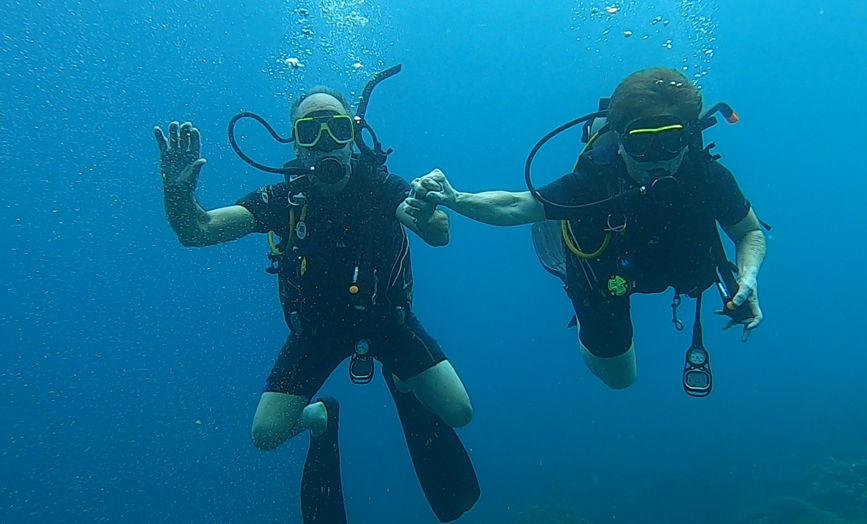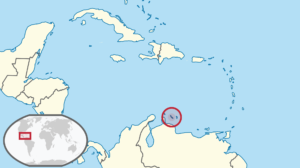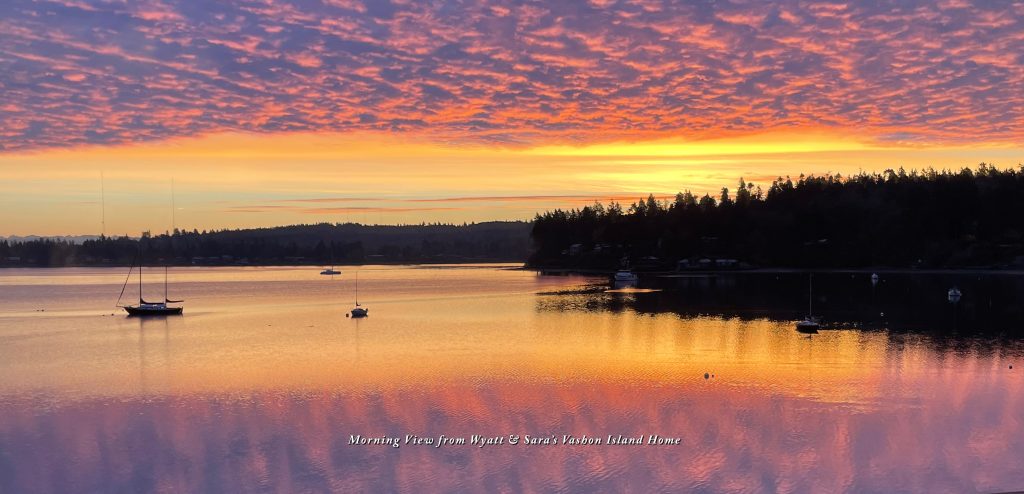
Diving in the Dutch Caribbean – April ’22
We were just getting comfortable with the experience of breathing and exploring underwater when we left Jamaica last December. We were newly-certified scuba divers with the nagging feeling that we might have received minimal instruction and not enough dive time to have confidence in our new skills. We knew we had to seek further instruction and accumulate more experience if we were going to safely pursue this new hobby further.

This perspective prompted us to embark on a second dive trip, this time on the Dutch Caribbean Island/Nation of Curaçao. The goal was to improve upon our Jamaican experience while getting a more concentrated dose of scuba diving instruction. Curaçao was an easy choice since there was a direct flight from New York and the country was allowing vaccinated visitors at a time when some Caribbean countries were not. It is also possible that our February planning may have been influenced by Curaçao’s mid-80-degree temps….
As with any trip, one can never know exactly how events will play out. You can usually count on there being some surprises, but this trip went smoothly, with almost no hiccups, and we learned a lot more about diving. In addition, we ate well, the temperatures held steady between 74 and 84 with a cooling breeze, every evening produced a beautiful sunset and we got to experience the relaxed nature of a tropical paradise.
Hover on a photo to enlarge; double-click to run slide show
Curaçao is a paradise, but not in the Garden-of-Eden sense: It is not lush. It is essentially a desert island, dry, with the only fresh water being manufactured by a desalinization plant or being captured as rainfall. Most of the plants are cacti. We chose Curaçao over its sister island, Bonaire (another dive mecca), because our research showed that there was a greater variety of things to do besides diving, and because the photos of its capital city, Willemstad, promised a charming European experience.
The island definitely reflects its Dutch history. Even the resort where we stayed had about 80% Dutch occupancy. All the staff spoke 4 languages (Dutch, English, Spanish, Papiamentu)and the currency is Dutch Guilders (ANG). Our menus were printed in Dutch and English but we never had any confusion because of language differences. Our dive instructors were both Dutch and, on there day off, the substitute divemaster (who was Swiss) also spoke at least 4 languages.
As it worked out we never left our resort during our stay, but this had more to do with the cost and availability of rental cars than with our desire to do other things. Once we experienced the underwater world of healthy reefs teeming with life we really had little need to stray far. What we found under the surface was very fulfilling.
[Special note: Prior to flying to Curaçao, we watched the award-winning documentary, Chasing Coral, a film about coral reefs around the world. It is a fascinating look at a largely misunderstood ecosystem that we are squandering. It offers insight into our motivation to visit healthy reefs while we can. We strongly recommend it. It shows on Netflix, and free with this link on YouTube.]
Click on image to watch the video (full screen for best viewing)
(There are 24 short video clips in a separate video gallery)
Where We Stayed
We stayed at Coral Estates Luxury Resort. It was lovely, but not as fancy as its name might lead one to believe. Unlike our Jamaican experience, no one greeted us in uniform with flutes of champagne, which suited us just fine. There were no organized trivia games in the pool or endless loud music either; the focus was on its natural surroundings and the sounds of the sea. Nothing felt forced. The “luxury” was the setting.
We were housed in an adults-only area. This was our choice since this option was advertised as being quiet and our previous Caribbean experience (Jamaica) had been one with lots of noise. In Curaçao, the nights were dark and quiet which made sleeping much easier.
There were three restaurants on the property, if one includes the bakery/pizzeria where one could (as we did) have a light breakfast at 7 a.m. or a sandwich or pizza throughout the day. The two other restaurants were by the water, serving a fuller menu. Downstairs, on the water served all three meals and was considered “fine dining” and the second-floor restaurant housed a bar and served lighter “pub fare”. We had our lunches – after diving – on the second floor; our dinners downstairs by the sea. Reservations were required.
We have never been fish eaters, but I tried to have a different fish meal most nights. They were all delicious, even the barracuda. In fact, over a week’s time we never had a meal that was anything less than superb.
Our proximity to the Equator meant we had to be extra vigilant about our exposure to the sun. We employed reef-friendly sunblock and wore hats, but still got plenty of color. I peeled.
Coral Estates Luxury Resort: A Gallery
Click on a photo to enlarge/zoom and see captions
The Diving
The primary motivation for this trip was to have an improved scuba diving experience and to further our diving skills. To achieve this we signed up for the next level PADI instructional course (Advanced Open Water Diver) and we sought out a 5-star PADI dive shop. After much research, we contacted Koen Van de Pol at Coral Divers and hoped for openings in their schedule. Coral Divers is located at Coral Estates Luxury Resort and is the reason we chose to stay there.
We gave ourselves a day to get acclimated to our new environment before we started our instruction. This turned out to be unnecessary, but gave us a chance to introduce ourselves, dispense with the obligatory paperwork and to try snorkeling, a first for both of us. Without planning it, this was the best possible affirmation of our choice to pursue this trip. As we cruised though the brilliant blue waters just yards from the shore we looked down upon some of the most beautiful fish and healthy corals that we had been studying only days before in the drab days of a New England winter. The ease at which we navigated these clear waters renewed our confidence for the dives that would follow. What we saw only strengthened our resolve to learn more about this underwater world that was still new to us.
The advanced course requires reading (e-Learning) and testing, which we did weeks before we left, and five “specialty dives”. Two of those dives are required: “Peak Performance Buoyancy” and a “Deep Dive”. The three optional dives were “Fish Identification”, “Underwater Navigation” and “Enriched Air Diving” (Nitrox). Each dive represented a new area of concentration on which to focus, while we continued improving our basic skills. We were fortunate to be the only two students on each of these dives and to have Koen or his wife Melissa as our divemaster. This personal attention proved important, as we were able to get clarification of any questions before and after each dive. There were obvious time constraints on the dives (the amount of remaining air, for example), but there was no limit placed on questions and answers.
Our 5 instructional dives were considered shore dives, meaning we embarked from shore , floated out to a drop point, then lowered ourselves to our starting depth, where we affirmed our “neutral buoyancy”, before finning our way to a coral reef. Coral Estates was fortunate to have 2 healthy “house reefs” that we explored and learned from. We communicated with each other through hand signals and kept track of our depth and remaining air with dive computers. The point at which we returned to base (usually based on amount of remaining air in our tank)was established before the dive and adhered to religiously. Most of the dives achieved a depth of approximately 40′-60′, but the Deep Dive went to 80′. Earning a certificate would allow us to dive to 100′.
Some land drills also factored into our training. Prior to our Navigation Dive, we walked a compass reading using a dive compass with a towel over our heads. Later we swam a course underwater using only compass points. Before our Fish ID Dive we discussed 12 groups of fish types as a way of classifying and identifying fish. We looked over a fish identification book, then chose certain fish that we would be asked to count and sketch as were diving on the reef. These exercises broadened our scope and made our dives far more interesting.
With each successive dive we recognized more facets of underwater life with the knowledge that we were embracing a vast new world with limitless possibilities. It was exhilarating. We saw fish of all sizes and colors, corals that took many shapes and began to understand how these things changed at different depths.
After our 5 instructional dives we signed up for 4 more “fun dives”, relaxed outings with no set agenda. Two of these were also shore dives but with a different divemaster. This was a subtle change for us but a valuable one as we began to broaden our dive experience. The last two dives were boat dives, where we joined a dozen or so other divers (divided into 2 groups) on an excursion to the Mushroom Forest reef, about a 40-minute catamaran ride from our base. It offered a unique view of corals that looked as if they had morphed into mushrooms, nothing like we had ever seen before. We also encountered stronger currents which were a challenge, but one we passed.
Our dives were definitely the highlight of our trip, but the entirety of the journey – the country, resort, meals, friendly people, helpful divers, new adventures – made this week a trove of incredible memories.
Diving in Curaçao: a Gallery
Click on a photo to enlarge/zoom and see captions
Outtakes from Curaçao: a Gallery
Click on a photo to enlarge/zoom. Up/down arrows to rotate














































































